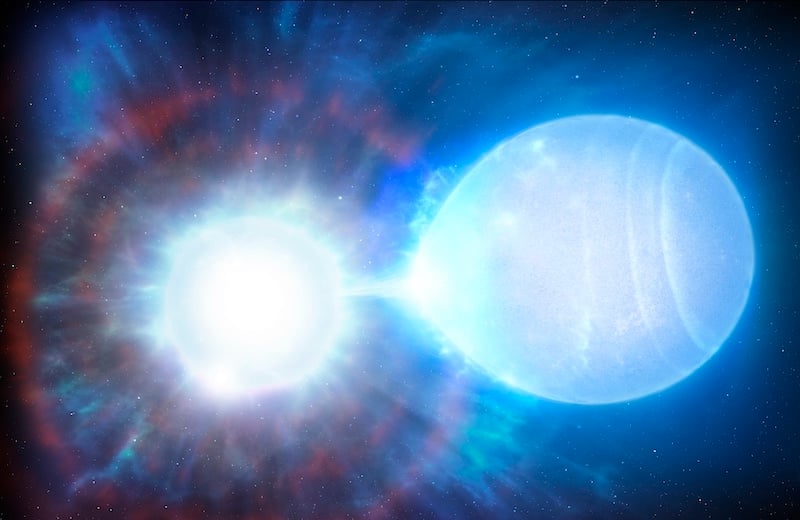A Type 1a supernova represents one of the most powerful and consistent explosions in our universe. These spectacular events occur when a white dwarf star - the dense, carbon-rich core left behind after a medium-sized star exhausts its nuclear fuel - reaches a critical mass threshold known as the Chandrasekhar limit (about 1.4 times the mass of our Sun.) What makes Type 1a supernovae particularly valuable is their remarkably consistent peak brightness, allowing them to serve as "standard candles" for measuring distances across the Universe. By comparing its apparent brightness in the sky with their known luminosity their distance can be calculated.
 G299 is a Type 1a supernova remnant (Credit : NASA/CXC/U.Texas)
G299 is a Type 1a supernova remnant (Credit : NASA/CXC/U.Texas)
In many cases, the extra material required to push the star over its critical mass threshold can be pulled from a companion star or merger with another white dwarf in a binary system. Once the white dwarf crosses this mass threshold, it triggers a runaway nuclear fusion reaction that releases an enormous amount of energy within seconds, completely obliterating the star.
Astronomers at the University of Warwick have discovered an extremely rare, high-mass binary star system just like this which is located a mere 150 light-years from Earth. What makes this finding particularly remarkable is that these two stars are on an inevitable collision course, destined to produce a Type 1a supernova.
The newly discovered binary system breaks records as the most massive of its kind ever confirmed, with the two white dwarfs possessing a combined mass of 1.56 times that of our Sun. This exceptional mass virtually guarantees the system's explosive fate, as it exceeds the critical threshold needed to trigger the supernova process.
"For years a local and massive double white dwarf binary has been anticipated, so when I first spotted this system with a very high total mass on our Galactic doorstep, I was immediately excited." - James Munday, PhD researcher at Warwick University.
Don't panic just yet though, the research team offers reassurance that, despite the system's relative proximity, the explosion won't occur for approximately 23 billion years, long after our Sun itself will have exhausted its fuel and died. Even when it does eventually detonate, the supernova poses no danger to our planet.
Currently, these white dwarfs are circling each other in an orbit taking just over 14 hours. Over the billions of years ahead, the emission of gravitational waves will gradually cause the stars to spiral closer. In the final moments before the supernova, their orbital period will have shortened dramatically to just 30-40 seconds as they race around each other at incredible speeds.
 SN 1994D, the bright spot at lower left is a type Ia supernova within its host galaxy, NGC 4526 (Credit : NASA/ESA)
SN 1994D, the bright spot at lower left is a type Ia supernova within its host galaxy, NGC 4526 (Credit : NASA/ESA)
The actual explosion will unfold through a "quadruple detonation" process. First, the surface of the mass gaining white dwarf will explode as material accumulates, triggering a secondary detonation in its core. The resulting blast will eject material outward, colliding with the companion white dwarf and igniting third and fourth detonations that will completely destroy both stars. It's estimated that the energy release will be of the order of a thousand trillion trillion times more powerful than the most powerful nuclear weapon ever created on Earth.
When this event finally unfolds billions of years from now, it will create an astronomically (sorry) bright point of light in Earth's night sky, if it still exists by then! The supernova would outshine virtually everything else visible to the naked eye, appearing up to ten times brighter than the full moon and approximately 200,000 times more luminous than Jupiter at its brightest.
Source :Warwick astronomers discover doomed pair of spiralling stars on our cosmic doorstep
 Universe Today
Universe Today
